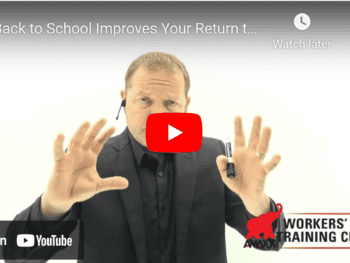
Big Mistake is Designing Program After Employee is Injured
For a transitional duty program to be effective, it needs to be properly established. This does not mean identifying a light-duty job for the employee once an employee has been injured. It means having a written policy on light duty work that is known to everyone in the company. When there is a written policy of providing transitional duty work, every employee will know that a light-duty or modified duty job will be available and required of them, if they are ever injured on the job. The supervisors and managers within the company should be educated on the details of the transitional duty program so they can properly explain it to any employee who is injured.
A transitional duty position should be designed for every current job within the company. The transitional duty job does not have to be in the same department as the injured employee’s original job. It can be anywhere in the company. The placement of the employee in a transitional duty position outside of the employee’s regular department is beneficial to the employee by broadening the employee’s skill base and knowledge of the company. Any training the employee needs to accomplish the transitional duty job should be provided during the first days on the temporary job assignment.
Click Link to Access Free PDF Download
“13 Research Studies to Prove Value of Return-to-Work Program & Gain Stakeholder Buy-In”
Transitional Program Should be Understood Throughout Company
All employees should understand that transitional duty jobs are temporary and are not a new permanent assignment for the employee. If the transitional duty is going to last more than 30 days, the employee should be moved to a second transitional duty job that allows for increased physical assertion, but still within the work restrictions set by the medical provider. The employee should be clearly told that as soon as the medical provider clears them to return to their regular duty job, they will be required to do so.
The business partners who are involved in the handling of the workers’ compensation claim need to understand that transitional duty is required of all injured employees who are able to work in some capacity. The nurse case manager and the designated adjuster or dedicated adjuster(s) assigned to your work comp claims should understand that your company will return all injured employees to work as soon as the medical provider states what work restrictions are necessary.
The medical provider, whether employer selected or employee selected, should be advised there is a transitional duty job available to the injured employee. The medical provider should be given both a copy of the physical requirements of the employee’s regular job and a copy of the physical requirements of the transitional duty job that will be available to the employee. If it is a non-emergency situation, the physical requirements or the regular job and of the transitional duty job should be given to the medical provider prior to the first medical visit. When this is not possible due to the need for immediate medical care, the physical requirements of both the regular duty job and the transitional duty job should be provided to the medical provider prior to the employee’s second medical appointment.
The employer should never allow the transitional duty job to interfere with the employee’s medical appointments, physical therapy appointments or other medical treatment. The supervisor in charge of the transitional duty job position should be provided the date of the next medical appointment immediately following the most recently completed medical appointment to minimize the interruption in productivity of the department where the injured employee is working.
Properly Designed & Implemented Program Ensures Success
The work comp coordinator within your company should coordinate the transitional duty position with the employee, with the supervisor of the transitional duty position and with the medical provider to be sure everyone is on board. Any issue that arises with the employee working in the transitional duty position can be addressed timely by the work comp coordinator. The work comp coordinator should also verify that the transitional duty job meets the work restrictions set by the medical provider.
FREE DOWNLOAD: “13 Research Studies to Prove Value of Return-to-Work Program & Gain Stakeholder Buy-In”
The establishment and implementation of the transitional duty program before it is needed is the key to a successful program. By designing your transitional duty program to accommodate the needs of the injured employees, you will ensure the success of your transitional duty program.

Author Michael Stack, CEO Amaxx LLC. He is an expert in workers’ compensation cost containment systems and helps employers reduce their workers’ comp costs by 20% to 50%. He works as a consultant to large and mid-market clients, is a co-author of Your Ultimate Guide To Mastering Workers Comp Costs, a comprehensive step-by-step manual of cost containment strategies based on hands-on field experience, and is the founder & lead trainer of Amaxx Workers’ Comp Training Center.
Contact: mstack@reduceyourworkerscomp.com.
Workers’ Comp Roundup Blog: https://blog.reduceyourworkerscomp.com/
©2019 Amaxx LLC. All rights reserved under International Copyright Law.
Do not use this information without independent verification. All state laws vary. You should consult with your insurance broker, attorney, or qualified professional.
FREE DOWNLOAD: “13 Research Studies to Prove Value of Return-to-Work Program & Gain Stakeholder Buy-In”
ESSENTIAL: This article is Return-to-Work Essentials content.















